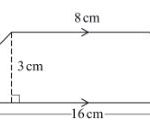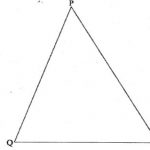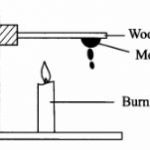THE KENYA NATIONAL EXAMINATIONS COUNCIL K.C.P.E 2013 Science
K.C.P.E 2013 Science
Time: 1 hour 40 minutes
Instructions to candidates (Please read these instructions carefully)
1. You have been given this question booklet and a separate answer sheet. The question booklet contains 50 questions.
2. Do any necessary rough work in this booklet.
3. When you have chosen your answer, mark it on the ANSWER SHEET, not in this question booklet.
How to use the answer sheet
4. Use an ordinary pencil only.
5. Make sure that you have written on the answer sheet:
Your index number
Your name
Name of your school
6. By drawing a dark line inside the correct numbered boxes mark your full Index Number (i.e. School Code Number and the three-figure Candidates Number) in the grid near the top of the answer sheet.
7. Do not make any marks outside the boxes.
Keep the sheet as clean as possible and do not fold it.
8. For each of the questions l~50, four answers are given. The answers are lettered A. B, C and D. In each case only
9. ONE of the four answers is correct. Choose the correct answer. 10. On the answer sheet, show the correct answer by drawing a dark line inside the box in which the letter you have chosen is written.
Example
In the Question Booklet.
4. Which one of the following components of blood is involved in clotting after injury?
A. Plasma.
B. White blood cells.
C. Red blood cells.
D. Platelets.
The correct answer is D.
On the answer sheet:
4. [A] [B] [C] [D] 14. [A] [B] [C] [D] 24. [A] [B] [C] [D] 34. [A] [B] [C] [D] 44. [A] [B] [C] [D]
In the set of boxes numbered 4, the box with the letter D printed in it is marked.
11. Your dark line Must be within the box.
12. For each question Only one box is to be marked in each set of four boxes.
This Question Paper consists of 6 printed pages and 2 blank pages.
1. Heat is transferred through a vacuum by
A. convection and conduction
B. convection only
C. conduction and radiation
D. radiation only.
2. The best procedure of separating a mixture of sand, maize and salt is
A. picking, dissolving, filtering, evaporating
B. dissolving, filtering, picking, evaporating
C. picking, filtering, dissolving, evaporating
D. dissolving, decanting, picking, evaporating.
3. To stop a moving object, the force applied should be
A. in the same direction as that of the moving object
B. opposite and less than that of the moving object
C. equal and in the opposite direction to that of the moving object
D. perpendicular and more than that of the moving object.
4. The set up shown below can be used to investigate the presence of a certain component of soil.
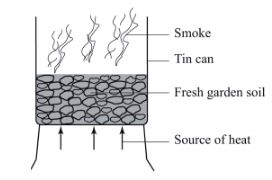
The soil component investigated is
A. organic matter
B. water
C. air
D. mineral salts.
5. Which of the following pairs of processes occurs when temperature decreases?
A. Melting and condensation.
B. Freezing and melting.
C. Contraction and evaporation.
D. Freezing and condensation.
6. Which one of the following animals has scales on its body?
A. Chameleon.
B. Whale.
C. Toad.
D. Newt.
7. The main reason why mothers are encouraged to breast feed their infants is because breast milk
A. is free from disease causing germs
B. is at the right temperature for infants
C. boosts infant immunity D. is easily digested by infants.
8. Splash erosion can be prevented by
A. use of gabions
B. mulching
C. terracing
D. contour farming.
9. Newton is the unit for measuring
A. weight
B. mass
C. volume
D. pressure.
10. Soil that is good for modelling has
A. high water drainage
B. rough texture
C. high capillarity
D. large air spaces.
11. The following are processes that take place during birth in humans
(i) Dilation of the cervix
(ii) Contraction of the uterus
(iii) Bursting of the amniotic bag
(iv) Pushing out of the baby
(v) Curling of the umbilical cord
Which of the following is the correct order of the processes? A. (i), (iii), (ii), (iv), (v). B. (i), (iii), (iv), (ii), (v). C. (ii), (i), (iii), (iv), (v). D. (ii), (iv), (iii), (i), (V).
12.A farmer practicing stall feeding is likely to feed animals on
A. pasture and fodder
B. pasture and concentrates
C. fodder and concentrates
D. concentrates only.
13. Which of the following statements is true about Vena Cava? It carries
A. deoxygenated blood
B. blood from the lungs
C. blood under high pressure
D. blood from the heart.
14. Which of the following materials are both opaque?
A. Mirror and fresh milk.
B. Paper smeared with oil and frosted glass.
C. Fresh milk and frosted glass.
D. Mirror and paper smeared with oil.
15. Which one of the following pairs is a source of electricity?
A. Dam and a dynamo.
B. Wind-driven turbine and a dam.
C. Torch and a dynamo.
D. Dry cell and a geothermal generator.
16. Which of the following statements is true about cumulus clouds?
A. Their presence is a sign of rain.
B. Appear at low altitude and spread out in fiat layers.
C. They are shaped like mountains.
D. They are dark grey in colour.
17. Which of the following planets are in the 2nd and 6th positions from the sun?
A. Mars and Jupiter.
B. Venus and Saturn.
C. Earth and Saturn.
D. Venus and Jupiter.
18. In which of the following pairs of levers is the load, effort and fulcrum likely to be in similar positions when in use?
A. Crowbar and claw hammer.
B. Wheelbarrow and spade.
C. Crowbar and spade.
D. Claw hammer and wheelbarrow.
19. Which of the following pairs of objects is correctly classified into magnetic and non-magnetic?
Magnetic – on-magnetic
Glass sheet- Tin can. Steel needle – Pencil lead. Copper coin – Steel wool. Razor blade – Staple pin. 20. The diagram below represents a set-up that is used to demonstrate a certain aspect of matter

The aspect investigated is
A. radiation
B. convection
C. conduction
D. expansion.
21. The following are uses of some components of air:
(i) germination
(ii) preserving soft drinks
(iii) electric bulbs
(iv) burning.
Which two uses are for the component that makes up 21% of air?
A. (i) and (iii).
B. (ii) and (iii).
C. (i) and (iv).
D. (ii) and (iv).
22. A pupil was walking towards the northern direction past an air strip and noticed a wind vane pointing to her right. In which direction was the wind blowing from?
A. East.
B. South.
C. North.
D. West.
23, The diagram below represents a simple electromagnet.
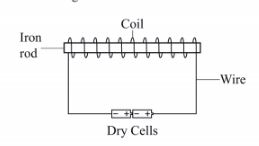
Which of the following energy transformations occur in the electromagnet?
A. Electrical —> Magnetic —> Chemical.
B. Chemical —> Magnetic —> Electrical.
C. Chemical a Electrical % Magnetic.
D. Magnetic A Chemical —> Electrical.
24. Vaccines given at birth protect an infant against
A. diphtheria and tuberculosis
B. tuberculosis and poliomyelitis
C. tetanus and diphtheria
D. whooping cough and poliomyelitis.
25. Farmers apply farm yard manure to the soil to
A. improve soil structure
B. release nutrients needed by plants immediately
C. provide specific nutrients
D. provide nutrients in right amounts.
26. Which pair of plants stores food in the roots?
A. Sweet potato and carrot.
B. Irish potato and arrow root.
C. Carrot and Irish potato.
D. Onions and cassava.
27. Which of the following groups of food crops is correctly classified into cereals, legumes and fruits?
Cereals – Legumes – Fruit
A. Peas – Millet – Orange.
B. Apple – Green grams – Beans.
C. Rice – Ground nuts – Pawpaw.
D. Wheat – Banana – Sorghum.
28. The diagram below shows some parts of a flower.
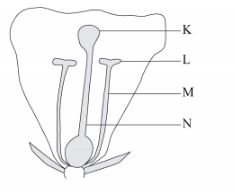
The parts representing the stigma and filament are
A. K and L
B. L and N
C. K and M
D. N and M.
29. Which of the following food chains is correct?
A. Grass —> grasshopper —> goat.
B. Maize —> mice —> snake.
C. Sunflower —> butterfly —> rabbit.
D. Grass —> antelope —> rhino.
30. Which of the following groups of animal feeds mainly provides a diet of proteins, carbohydrates and Fats respectively?
A. Desmodium, clover, sweet potato vines.
B. Lucem, maize stalks, oats.
C. Napier grass, swcct potato vines, maize stalks.
D. Lucem, desmodium, napier grass.
31. Which of the following groups of foods would provide nutrients suitable for a child suffering from kwashiorkor?
A. Sorghum, carrots, sweet potatoes.
B. Oranges, Irish potatoes, sugar cane.
C. Beef, peas, milk.
D. Mangoes, arrow roots, spinach.
32. Bilharzia can be prevented by
A. boiling water before drinking
B. wearing gumboots when walking in stagnant water
C. draining stagnant water from around the homestead
D. covering latrines after use.
33. Which of the following uses of water are recreational only?
A. Transport, cleaning, swimming.
B. Cleaning, boat racing, mixing chemicals.
C. Swimming, fishing, boat racing.
D. Fishing, transport, mixing chemicals.
34. Which of the following statements about HIV infected persons is correct?
Infected persons
A. can only be taken care of by health workers
B. need to visit hospitals for cure
C. should be provided with a balanced diet
D. should be discouraged from playing with others.
35. Excessive use of herbicides and pesticides affect the soil by reducing the
A. number of animals in the soil
B. nutrients in the soil
C. humus content in the soil
D. water retention in the soil.
36. Which of the following parts of the human breathing system are both involved in cleaning, warming and moistening air?
A. Diaphragm and trachea.
B. Lungs and diaphragm. C. Nose and lungs. D. Trachea and nose.
37.Which of the following pairs of livestock parasite control methods can control liver flukes?
A. Rotational grazing and deworming.
B. Dipping and spraying of animals.
C. Rotational grazing and spraying of animals.
D. Deworming and dipping.
38. In which of the following are the characteristics of solids and liquids correctly matched?
Solids – Liquids
A. Definite volume – Definite shape.
B. No definite volume – Definite shape.
C. Definite volume – No definite shape.
D. No definite shape – Definite volume.
39. Which of the following groups of objects consists of only objects that would sink in water?
A. Piece of chalk, steel needle, cork.
B. Nail, piece of glass, stone.
C. Bottle top, nail, cork.
D. Piece of chalk, plastic bottle, polythene bag.
40. The following are reasons for fitting a tap near the bottom of a tank except
A. making gravitational force to act on water
B. making water to flow faster
C. to increase pressure
D. to let all the water out.
41. The main reason why murram is placed on roads is to
A. absorb rain water
B. make the roads last longer
C. increase grip with tyres
D. make the roads more attractive.
42. Which of the following groups of products are correctly classified according to the farm animals producing them?
Cattle – Sheep – Goats
A. Dairy – Beef – Wool.
B. Beef – Dairy – Wool.
C. Mutton – Wool – Dairy.
D. Beef – Mutton – Dairy.
43. The following processes are involved in the formation of a zygote in plants:
(i) Growth of pollen tube
(ii) Pollination
(iii) Fusion
(iv) Pollen tube breaks.
The correct order of the processes is
A. (ii), (i), (iv), (iii)
B. (i), (ii), (iv), (iii)
C. (ii), (i), (iii), (iv)
D. (iv), (i), (iii), (ii).
44. Which of the following only consists of energy giving foods?
A. Lemon and honey.
B. Butter and coconut.
C. Eggs and fish.
D. Bread and pineapple.
45. Which of the following statements describes soft water? Soft water
A. is clear and clean
B. requires a lot of soap for washing
C. is safe for drinking
D. is water that has been boiled.
46. In an activity to investigate mixing of liquids, liquid P mixed with liquid Q. Liquid R did not mix with Liquid P and Q. Liquid R mixed with cooking oil. Which one of the following correctly represents liquids P, Q and R? P —- Q —- R
A. Water – Milk – Kerosene.
B. Kerosene – Water – Milk.
C. Milk – Kerosene – Water.
D. Water – Kerosene – Milk.
47. The diagram below represents a set up used to demonstrate a certain property of light.

Which one of the following statements is correct about the set up? Light is
A. refracted from P to the eye
B. reflected from Q to the eye
C. refracted from Q to the eye
D. reflected from P to the eye.
48. Which one of the following pairs of materials will pollute soil‘?
A. Saw dust and artificial fertilizer.
B. Plastics and artificial fertilizer.
C. Wood ash and saw dust.
D. Plastics and iron filings.
49. In a certain investigation pupils used a straight pipe to observe a candle flame. They then bent the pipe and observed again.
Which aspect of light was being investigated‘?
A. Formation of shadows.
B. Uses of light.
C. Sources of light.
D. How light travels.
50. A pupil was blindfolded and asked to listen as a bell was rang from different positions.
Which aspect of sound was being investigated?
A. Direction of sound.
B. Effects of sound pollution.
C. Loud and soft sounds.
D. Meaning of special sounds.
Free KNEC KCPE Past Papers Science 2013 Answers
K.C.P.E 2013
MARKING SCHEME
KCPE 2013 ANSWERS
# Science
1 D
2 A
3 C
4 A
5 D
6 A
7 C
8 B
9 A
10 C
11 C
12 C
13 A
14 A
15 D
16 C
17 B
18 A
19 B
20 B
21 C
22 A
23 C
24 B
25 A
26 A
27 C
28 C
29 B
30 B
31 C
32 B
33 C
34 C
35 A
36 D
37 A
38 C
39 B
40 A
41 C
42 D
43 A
44 B
45 D
46 A
47 C
48 D
49 D
50 A
